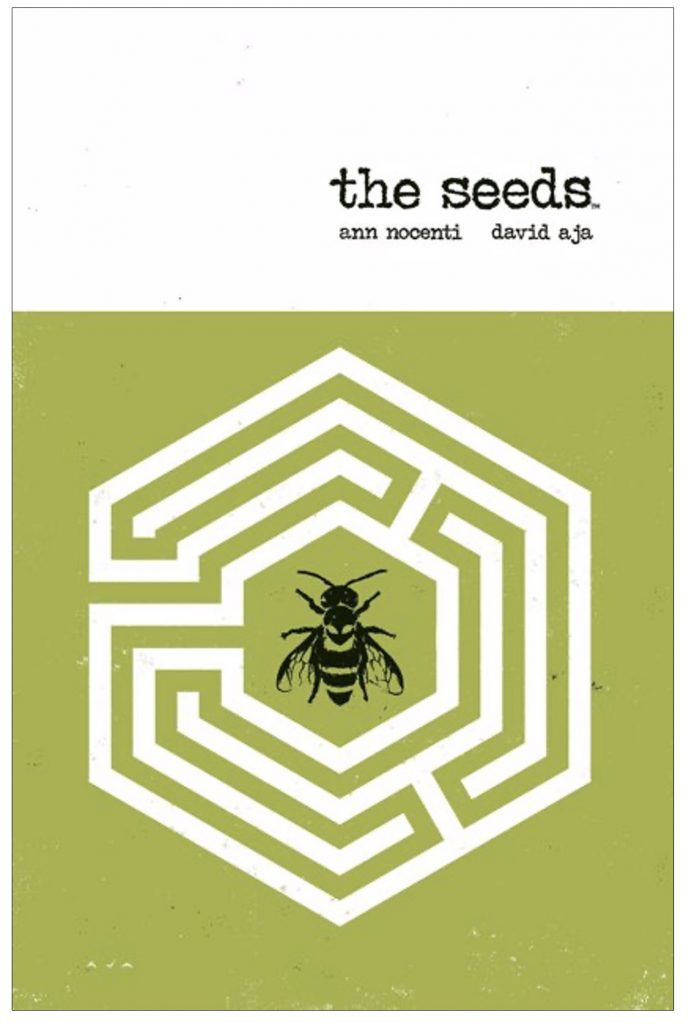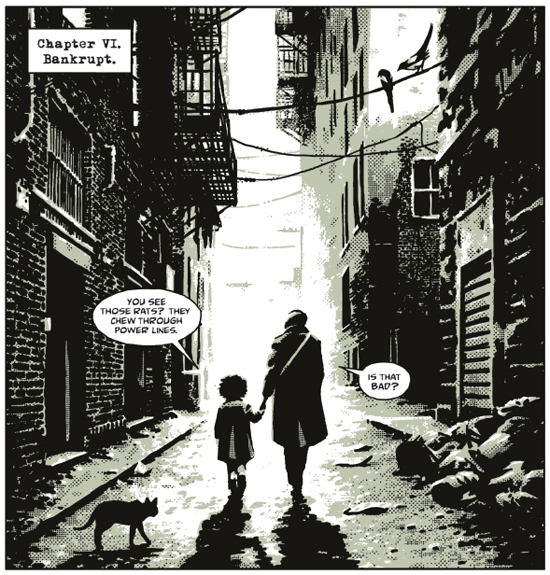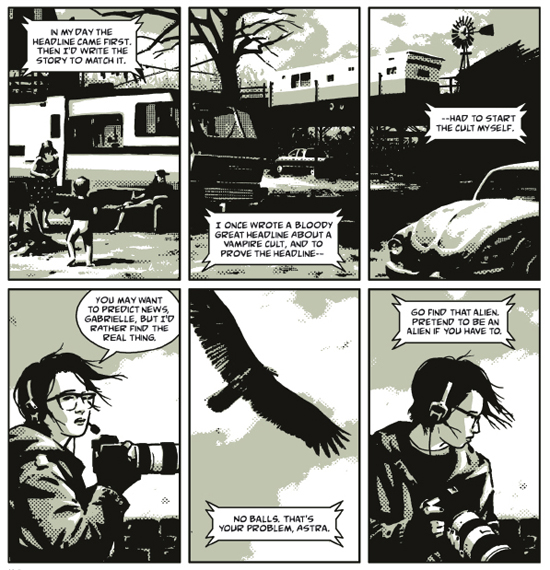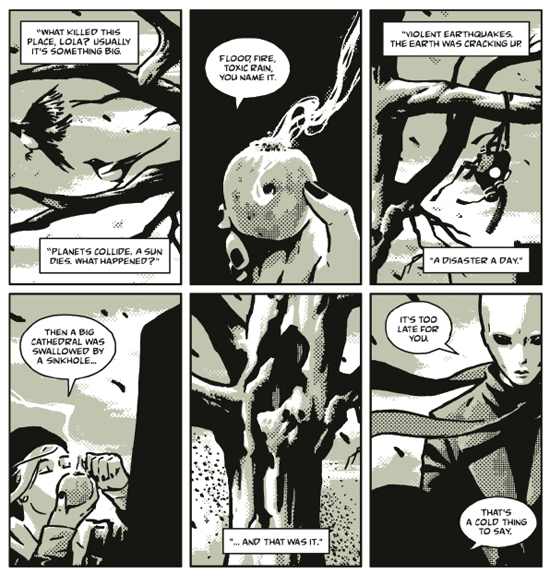THE SEEDS
By:
December 22, 2020

Erasure is the dominant medium of this moment. As we move away from a world we thought we understood, we’re all faced with the decision of what to leave out. And nothing is more fertile than the spaces and shadows, the blanks and gaps of Ann Nocenti & David Aja’s The Seeds (Dark Horse/Berger Books). Begun with two issues in 2018 and then hiatused until its release as a graphic novel this week — a sequence that dates to long before we all got accustomed to life suspended indefinitely and resuming without notice — The Seeds is the perfectly suited storyline for a future that’s moving forward but all in starts and stops; the image of an existence that’s being penciled in.

The feeling of having outlived the end of time is palpable, and Nocenti & Aja create the sense of a period piece set in an era that hasn’t happened yet, but place us within it vividly. Aja is the master of a kind of retroactive minimalism; his settings don’t feel built succinctly from bare elements, but worn down eloquently from former abundance and ferment. The monochrome palette (white, black and a moss- or mold-like green), the high-contrast rendering, the offhand kipple of peeling walls and cobbled tech and decomposing urban limbos feel like history engraved on an evanescent canvas of wheatpasted handbills, faded tabloid newsprint, scrawled and stenciled street art. But Aja’s subject isn’t what’s not there, but what goes unnoticed; in syncopation with Nocenti’s text, a score of bleak vistas and microscopic views, of repeated patterns hinting at a higher design beyond what any language can speak, tells the layer of the story that stays silent behind what its characters say. Zooming in on subliminal hexagon/honeycomb motifs, crisscrossed with old-school mechanical dot-matrix tones for shading, the world of The Seeds looks like it is disintegrating before our eyes, but perpetually reconstituting.

It is that metaphor of regeneration that’s embedded both in the book’s title and theme. Everything is dying back; Astra, a reporter for the “Scoop” newspaper/website, is a true journalist in a sump of click-bait, essentially an endangered species in a system going extinct; she works near a border-wall that runs right through the boroughs of New York City, and stands between the collapsing consumer-topia on Astra’s side and a back-to-the-land zone of anti-tech agrarian squatters, one part Walden to one part Chernobyl. Astra seeks the story of whether this represents an end or a beginning, while other harvests, or reapings, cycle around her, including the undercover comings and goings of some commuter extraterrestrials here to collect specimens from a waning world, and Lola, the vaguely mystical tenement-dweller who falls in love with one of them and follows him to the other side of the wall. Astra crosses paths with the couple, colliding with the conspiracy/exploitation story that could make her career and kill her conscience, while various other characters process the apparent end-times in differing ways, from a farm family struggling to coax cooperation from the earth like an Adam and Eve with no garden, to a pair of rival inventor-cowboy billionaires making bets on their competing sci-fi survival schemes like God and the Devil arguing over Job.

The poetry of Aja’s visual rhythms is matched by Nocenti’s spare, staccato dialogue, compressed but utterly individualized and human, a kind of vernacular haiku spoken by people conscious of having maybe minutes to make every word count. There might be no one taking the tally, but the lives and perspectives and actions of the least of us do add up, and The Seeds ends, openly, on a rising tide gathered up from the cracks in the walls and sidewalks, a next-page swept clean of everything but possibility. The wave may founder and the shore may be unreachable, but by now the best we can really ask for is a utopian maybe. There are many directions The Seeds’ engrossing narrative and endearing cast could go from here, but it’s probably good for us that we don’t follow them to any conclusion. The book, its world and our planet took a long way to get where they are, and this is no time to think of anything as being over.
MORE POSTS by ADAM McGOVERN: OFF-TOPIC (2019–2025 monthly) | textshow (2018 quarterly) | PANEL ZERO (comics-related Q&As, 2018 monthly) | THIS: (2016–2017 weekly) | PEOPLE YOU MEET IN HELL, a 5-part series about characters in McGovern’s and Paolo Leandri’s comic Nightworld | Two IDORU JONES comics by McGovern and Paolo Leandri | BOWIEOLOGY: Celebrating 50 years of Bowie | ODD ABSURDUM: How Felix invented the 21st century self | KOJAK YOUR ENTHUSIASM: FAWLTY TOWERS | KICK YOUR ENTHUSIASM: JACKIE McGEE | NERD YOUR ENTHUSIASM: JOAN SEMMEL | SWERVE YOUR ENTHUSIASM: INTRO and THE LEON SUITES | FIVE-O YOUR ENTHUSIASM: JULIA | FERB YOUR ENTHUSIASM: KIMBA THE WHITE LION | CARBONA YOUR ENTHUSIASM: WASHINGTON BULLETS | KLAATU YOU: SILENT RUNNING | CONVOY YOUR ENTHUSIASM: QUINTET | TUBE YOUR ENTHUSIASM: HIGHWAY PATROL | #SQUADGOALS: KAMANDI’S FAMILY | QUIRK YOUR ENTHUSIASM: LUCKY NUMBER | CROM YOUR ENTHUSIASM: JIREL OF JOIRY | KERN YOUR ENTHUSIASM: Data 70 | HERC YOUR ENTHUSIASM: “Freedom” | KIRK YOUR ENTHUSIASM: Captain Camelot | KIRB YOUR ENTHUSIASM: Full Fathom Five | A 5-part series on Jack Kirby’s Fourth World mythos | Reviews of Annie Nocenti’s comics Katana, Catwoman, Klarion, and Green Arrow | The curated series FANCHILD | To see all of Adam’s posts, including HiLo Hero items on Lilli Carré, Judy Garland, Wally Wood, and others: CLICK HERE
